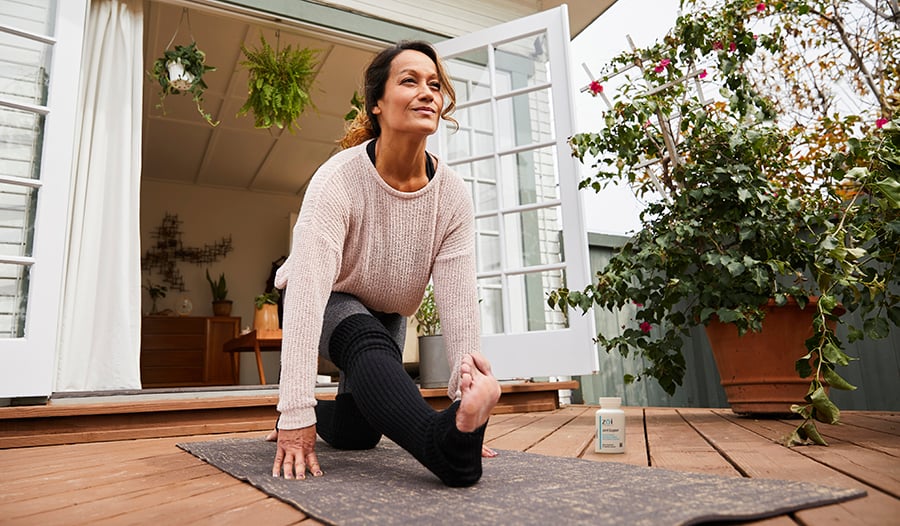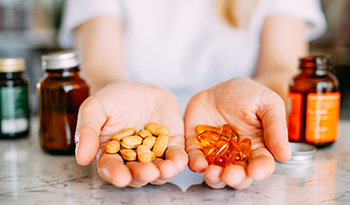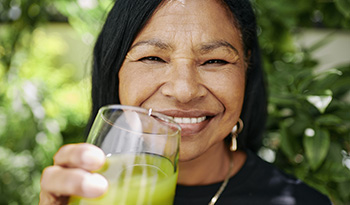Natural Ways to Reverse Bone Loss and Strengthen Bones

The musculoskeletal system is an incredible set of organs and tissues that regulate immune function, strength, mineral balance, and metabolic health in the body. As we age, the musculoskeletal system has the power to keep our metabolism and mood high, to prevent falls and fractures, and even to keep us protected against infection and early death.
That’s a pretty impressive list!
So how do we take care of one of the most important parts of our musculoskeletal system—our bones—using natural medicine, food, and lifestyle? This article explains it all.
What Are Bones And What Do They Do For Us?
Believe it or not, bones are actually considered organs. This is because they do far more than simply prop us up or help us move; they are actually alive and have their own blood supply! The 270 bones that we’re born with as babies will change, fuse, form, and reform throughout our lifetimes. As adults, we normally wind up with 206-217 by the time they’re done developing.
Along the way, bones provide us with important immune cells, red blood cells, and minerals for blood homeostasis. They protect our important organs like the lungs and heart. At any age, keeping bones that are densely filled with their main ingredients—collagen, minerals, and hydroxyapatite—strong will help us resist fractures and breaks when we fall.
So how do we tell if our bones are healthy or not? And how do we use the science of their function to create incredible natural health treatment protocols to keep them healthy?
What Is Bone Density?
DEXA scans are a definitive way to measure bone density. DEXA stands for dual-energy x-ray absorptiometry; they’re similar to a regular x-ray that you may have gotten in the doctor’s office in that they allow us to see through skin and other tissues so that we can visualize bone. Unlike a simple x-ray, however, DEXA scans allow us to measure the density of bones.
Put simply, the more dense your bones are, the healthier they are (with rare exceptions). Your doctor will make a calculation based on your DEXA reading that gives your bones a numeric score compared to the bones of the healthiest people in our population. If your score falls enough below normal to warrant treatment, you generally will hear your doctor use words like “low bone density,” “osteopenia,” or “osteoporosis.”
Your doctor will recommend DEXA scans at regular intervals based on your age, risk factors, and any suspected bone fractures or breaks. It’s always a good idea to get a DEXA scan because it gives us the information we can’t see or measure from outside of the body. The sooner you know about low bone density, the sooner you can fix it. That’s what preventive medicine is all about!
Best Supplements For Bone Health
Calcium for Bone Density
Your bones are only made from what you eat and drink! Because our bones are mostly made of calcium, it’s important to consume enough calcium each day in your diet. The United States Food and Drug Administration (FDA) recommends at least 1000mg per day for most adults. Good sources of calcium include yogurt, orange juice, mozzarella cheese, milk, sardines, soy, and salmon. If you don’t consume these foods frequently, then you may be one of the 30% of adults who are estimated to have a calcium-deficient diet. You can supplement with a good calcium supplement that contains approximately 600-1200mg of calcium per day. Ask your doctor before starting a calcium supplementation routine, as there is some evidence that calcium supplementation can be unsafe for people who smoke or who have high cholesterol. Most multivitamins don’t contain enough calcium to provide the Recommended Dietary Intake because calcium competes with other minerals for absorption, so do your homework along with your healthcare team to make sure your supplements are providing enough calcium to meet any gaps in your diet long-term.
Vitamin D Helps to Build Bone
Getting enough vitamin D is also critical for bone health because it allows our gastrointestinal systems to absorb the calcium we eat, and allows our parathyroid glands to signal to our bones to keep growing. Getting enough vitamin D from the diet is difficult unless you really enjoy cod liver oil, trout, or salmon, and consume at least a serving of those each day. The FDA recommends 600IU per day of vitamin D for most adults to prevent deficiency. If you are already deficient, you need more to reach normal blood levels. Additionally, our skin makes vitamin D when exposed to the sun, but with the amount of time most adults spend indoors or covered in sunscreen, sun exposure is not an adequate way to meet your RDI. Instead, I have most of my clients take a daily supplement so that they don’t have to worry about getting deficient. Whether you choose a multivitamin that has enough vitamin D, take a separate vitamin D supplement, or even chew a vitamin D gummy, just make sure to pick a form and dose that your doctor approves of.
Protein and Potassium Prevent Osteosarcopenia
Studies show that diets high in potassium and protein help protect our musculoskeletal system from conditions like osteoporosis, osteopenia, and osteosarcopenia (low bone density and low muscle mass) when combined with adequate calcium and vitamin D intake. The easiest way to ensure this is to eat plenty of plant foods (at least servings of fruits and vegetables per day) and to consume enough protein in the form of meats, dairy products, nuts, and beans. One of my favorite ways to accomplish both at the same time is to have people make smoothies with plant-based protein powders, and chilis with lots of veggies and beans.
Trace Minerals and Collagen
Bones are made of more than just calcium. They also contain collagen and trace minerals like copper and manganese. Natural sources of collagen include the matrix of animal bones (think bone broth and collagen powder). As a society, we tended to under-consume collagen for the last 50 years, but the recent resurgence in the popularity of collagen products is helping to reverse that trend. Trace minerals are found in plant foods like root vegetables, fruits, nuts, beans, and seeds. I personally add trace mineral drops to any water I consume, since it’s an easy way to make sure I meet my goals and helps to make up for the fact that our soils contain fewer trace minerals than they did 200 years ago. As long as you don’t have kidney issues, it’s probably safe for you to do the same. Next time you meet with your health professional, ask them what dose of these nutrients is ideal for you.
The Most Effective Exercises For Building Bone
Weightlifting Builds Bones, Reverses Osteopenia and Osteoporosis
Studies suggest that when inactive adults begin to lift weights, they can increase their bone mineral density by up to 3%! This is big news for anyone with osteoporosis or osteopenia. It means that you can reverse your disease naturally by simply adopting a regular resistance training program, combined with a healthy diet.
It should be said here that if you already have reduced bone mineral density, you should work with a doctor, physical therapist, or other qualified health professionals to determine what type of resistance training program will be safe and effective for you.
The reason that resistance training or weightlifting works to increase bone density is that bones grow in response to pressure and weight. When we put more weight on our bodies, our bones sense the increased load and send signals to our bone matrix to become denser. The heavier you lift (within reason) the stronger your bones will become. Weightlifting also increases circulating levels of hormones like testosterone and growth hormone, which have a beneficial effect on bone density. Ask your doctor for help in making a plan that includes healthy weight lifting or resistance training for optimal bone health.
Reducing Risk Factors For Low Bone Mineral Density
Modifiable risk factors for osteoporosis include inadequate intakes of calcium and vitamin D, being underweight, being overweight, consumption of more than two alcoholic drinks per night, smoking, and lack of activity.
Drinking and Smoking
If you drink too much (<2 drinks per night) or smoke cigarettes, work with your doctor to develop a holistic plan to cut back or eliminate these habits. Some of my favorite tips for backing off alcohol include increasing your consumption of seltzers and calming teas rather than a usual nightcap.
BMI
If you are over or underweight, work with a nutrition professional and fitness expert to help you reach your optimal BMI. Thankfully, the tips above regarding weight lifting and optimal nutrition should help you get there!
How Bone Building Really Works
When we say “build bone,” what we really mean is “increase bone density by reducing bone turnover and increasing osteoblast activity to build new bone matrix.” That’s a mouthful, so I’ll explain.
When you reduce bone turnover, you reduce the rate at which your body breaks down existing bone. This helps us keep the bones we’ve got around for longer periods of time.
When we increase osteoblast activity, we increase the rate at which our bodies fortify our existing bones and create new bone tissue from minerals like calcium, strontium, and boron. This helps us make the bones we have even stronger.
Estrogen and other hormones help to keep the balance between bone breakdown and bone-building at an even pace. This is why young people and premenopausal women tend to have a lower risk of osteoporosis. Thyroid and parathyroid hormones also play a role in regulating this activity, as does cortisol—a hormone produced by our adrenal glands. If you’re in menopause or have a thyroid problem, ask your doctor about specific considerations for bone-building, and work with a holistic approach to heal these issues using whatever combination of prescriptions, supplements, lifestyle, and nutrition they recommend.
Takeaway
You have so much control over your bone health! By optimizing your diet, supplement, and fitness routines, you can maximize your chances of preventing and reversing osteoporosis and osteopenia long-term.
References:
- Bailey, Regan L., et al. “Estimation of Total Usual Calcium and Vitamin D Intakes in the United States.” The Journal of Nutrition, vol. 140, no. 4, 24 Feb. 2010, pp. 817–822, www.ncbi.nlm.nih.gov/pmc/articles/PMC2838624/, 10.3945/jn.109.118539. Accessed 5 Apr. 2021.
- Bijelic, Radojka, et al. “Risk Factors for Osteoporosis in Postmenopausal Women.” Medical Archives, vol. 71, no. 1, 2017, p. 25, pubmed.ncbi.nlm.nih.gov/28428669/, 10.5455/medarh.2017.71.25-28. Accessed 5 Apr. 2021.
- Bonjour, Jean-Philippe. “Protein Intake and Bone Health.” International Journal for Vitamin and Nutrition Research, vol. 81, no. 23, 1 Mar. 2011, pp. 134–142, pubmed.ncbi.nlm.nih.gov/22139564/, 10.1024/0300-9831/a000063. Accessed 5 Apr. 2021.
- Calvez, J, et al. “Protein Intake, Calcium Balance and Health Consequences.” European Journal of Clinical Nutrition, vol. 66, no. 3, 30 Nov. 2011, pp. 281–295, pubmed.ncbi.nlm.nih.gov/22127335/, 10.1038/ejcn.2011.196. Accessed 5 Apr. 2021.
- Cooper, C., et al. “Dietary Protein Intake and Bone Mass in Women.” Calcified Tissue International, vol. 58, no. 5, May 1996, pp. 320–325, pubmed.ncbi.nlm.nih.gov/8661965/, 10.1007/bf02509379. Accessed 5 Apr. 2021.
- Dontas IA;Yiannakopoulos CK. “Risk Factors and Prevention of Osteoporosis-Related Fractures.” Journal of Musculoskeletal & Neuronal Interactions, vol. 7, no. 3, 2021, pubmed.ncbi.nlm.nih.gov/17947811/, . Accessed 5 Apr. 2021.
- Jugdaohsingh, R. “Silicon and Bone Health.” The Journal of Nutrition, Health & Aging, vol. 11, no. 2, 2007, pp. 99–110, www.ncbi.nlm.nih.gov/pmc/articles/PMC2658806/. Accessed 5 Apr. 2021.
- Kenkre, JS, and JHD Bassett. “The Bone Remodelling Cycle.” Annals of Clinical Biochemistry: International Journal of Laboratory Medicine, vol. 55, no. 3, 4 Mar. 2018, pp. 308–327, pubmed.ncbi.nlm.nih.gov/29368538/, 10.1177/0004563218759371. Accessed 5 Apr. 2021.
- Khosla, Sundeep, and Lorenz C Hofbauer. “Osteoporosis Treatment: Recent Developments and Ongoing Challenges.” The Lancet Diabetes & Endocrinology, vol. 5, no. 11, Nov. 2017, pp. 898–907, www.ncbi.nlm.nih.gov/pmc/articles/PMC5798872/, 10.1016/s2213-8587(17)30188-2. Accessed 5 Apr. 2021.
- Kraemer, William J, and Nicholas A Ratamess. “Hormonal Responses and Adaptations to Resistance Exercise and Training.” Sports Medicine, vol. 35, no. 4, 2005, pp. 339–361, pubmed.ncbi.nlm.nih.gov/15831061/, 10.2165/00007256-200535040-00004. Accessed 5 Apr. 2021.
- Mangano, Kelsey M., et al. “Dietary Protein Is Beneficial to Bone Health under Conditions of Adequate Calcium Intake.” Current Opinion in Clinical Nutrition and Metabolic Care, Nov. 2013, p. 1, www.ncbi.nlm.nih.gov/pmc/articles/PMC4180248/, 10.1097/mco.0000000000000013. Accessed 5 Apr. 2021.
- New, Susan A, and D Joe Millward. “Calcium, Protein, and Fruit and Vegetables as Dietary Determinants of Bone Health.” The American Journal of Clinical Nutrition, vol. 77, no. 5, 1 May 2003, pp. 1340–1341, academic.oup.com/ajcn/article/77/5/1340/4689865, 10.1093/ajcn/77.5.1340. Accessed 5 Apr. 2021.
- “Office of Dietary Supplements - Vitamin D.” Nih.gov, 2017, ods.od.nih.gov/factsheets/VitaminD-HealthProfessional/. Accessed 5 Apr. 2021.
- “Office of Dietary Supplements - Vitamin D.” Nih.gov, 2017, ods.od.nih.gov/factsheets/VitaminD-HealthProfessional/. Accessed 5 Apr. 2021.
- RSNA, America. “Bone Densitometry (DEXA, DXA).” Radiologyinfo.org, 2020, www.radiologyinfo.org/en/info.cfm?pg=dexa#:~:text=Bone%20densitometry%2C%20also%20called%20dual,hips)%20to%20measure%20bone%20loss.. Accessed 5 Apr. 2021.
- Russow, Gabriele, et al. “Anabolic Therapies in Osteoporosis and Bone Regeneration.” International Journal of Molecular Sciences, vol. 20, no. 1, 26 Dec. 2018, p. 83, www.ncbi.nlm.nih.gov/pmc/articles/PMC6337474/, 10.3390/ijms20010083. Accessed 5 Apr. 2021.
- Shams-White, Marissa M, et al. “Dietary Protein and Bone Health: A Systematic Review and Meta-Analysis from the National Osteoporosis Foundation.” The American Journal of Clinical Nutrition, 12 Apr. 2017, p. ajcn145110, pubmed.ncbi.nlm.nih.gov/28404575/, 10.3945/ajcn.116.145110. Accessed 5 Apr. 2021.
- Westcott, Wayne L. “Resistance Training Is Medicine.” Current Sports Medicine Reports, vol. 11, no. 4, 2012, pp. 209–216, journals.lww.com/acsm-csmr/Fulltext/2012/07000/Resistance_Training_is_Medicine__Effects_of.13.aspx, 10.1249/jsr.0b013e31825dabb8. Accessed 5 Apr. 2021.
ΑΠΟΠΟΙΗΣΗ ΕΥΘΥΝΗΣ:Αυτό το Κέντρο Ευεξίας δεν προορίζεται να παρέχει διάγνωση...













































































 Πίνακας περιεχομένων
Πίνακας περιεχομένων














